Largest Creative Test Ever Conducted Reveals AM/FM Radio Ads Drive Purchase Intent for Tier Two Automotive
New creative effectiveness study dispels misperceptions plaguing tier two auto AM/FM radio ads and provides best practices to drive high ROI
Tier two automotive, the middle child of the automotive advertising hierarchy, is situated between the brand messaging of national advertisers in tier one and local dealers in tier three. Tier two campaigns support regional dealer associations to drive purchase around key sales events.
Disclaimers and creative concerns keep domestic auto brands away from AM/FM radio
Tier two campaigns generally involve an offer, which in turn requires a disclaimer. For TV ads, disclaimers are depicted in small print on the lower third of the screen. Tier two radio ads require the disclaimer to be part of the ad.
The presence of disclaimers in tier two radio ads have caused negative perceptions over creative quality among regional dealer groups. Radio ads with disclaimers are perceived as “uninspiring” and “hard to listen to.” As a result, domestic dealer groups have steered clear of AM/FM radio for their tier two campaigns.
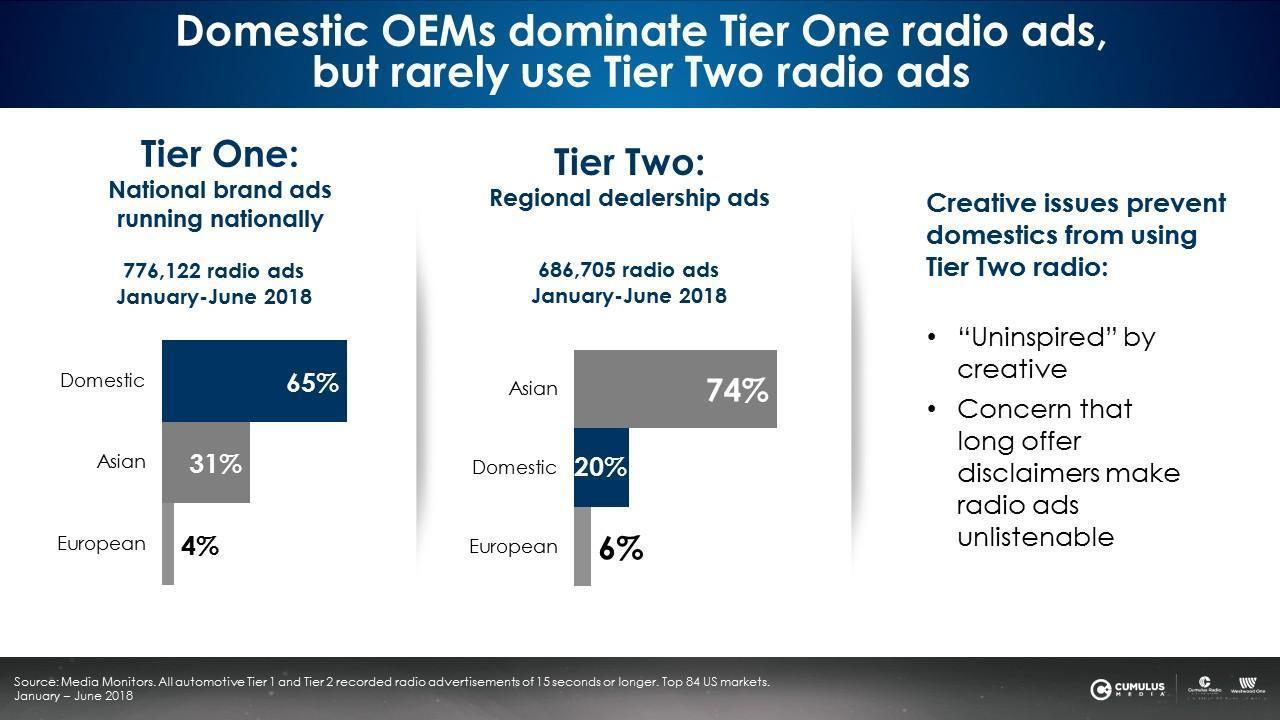
When it comes to tier two, domestic brands only represent 20% of radio ad occurrences, while Asian brands represent a whopping 74%.
So do disclaimers ruin tier two radio ads? How do tier two auto radio ads perform when subjected to rigorous creative testing benchmarked against thousands of other radio ads? We decided to find out.
Largest creative study of tier two auto radio ads ever conducted
CUMULUS MEDIA and Westwood One, America’s largest radio network, are believers in creative testing and challengers of industry perceptions.
In partnership with the VERITONIC audio effectiveness platform, CUMULUS MEDIA spearheaded the largest automotive radio creative test ever conducted to measure consumer response to tier two ads. “The value of data — of quantifiable proof — is never more powerful than when it’s correcting a perception that’s been long-taken as a given,” said VERITONIC CEO and co-founder Scott Simonelli. “This work brings a quantifiable truth to audio marketing, and by doing so, helps the industry deliver better advertising results.”
Twenty 60-second tier two automotive ads from a diverse group of dealer associations were tested among adults 18+ in the market for a vehicle in the next 12 months. The average disclaimer length was 16.4 seconds. The longest disclaimer was 27 seconds and the shortest disclaimer was 5 seconds.
Data was collected from over 873 auto-intenders. The ads were tested for emotional impact and purchase intent.
Our objective: Answer the main question barring AM/FM radio from tier two investment. Do disclaimers ruin tier two ads?
Here’s what we found:
Tier two automotive ads are some of the best testing radio ads in America: Out of VERITONIC’s massive audio test database of 2,330 ads, the tier two automotive ads tested in the top 20%. The 20 tier two auto ads have an average total score of 76, outperforming the tier one auto average of 66 by +15%. If there were any concerns over tier two auto radio creative quality, these findings put those worries to bed.
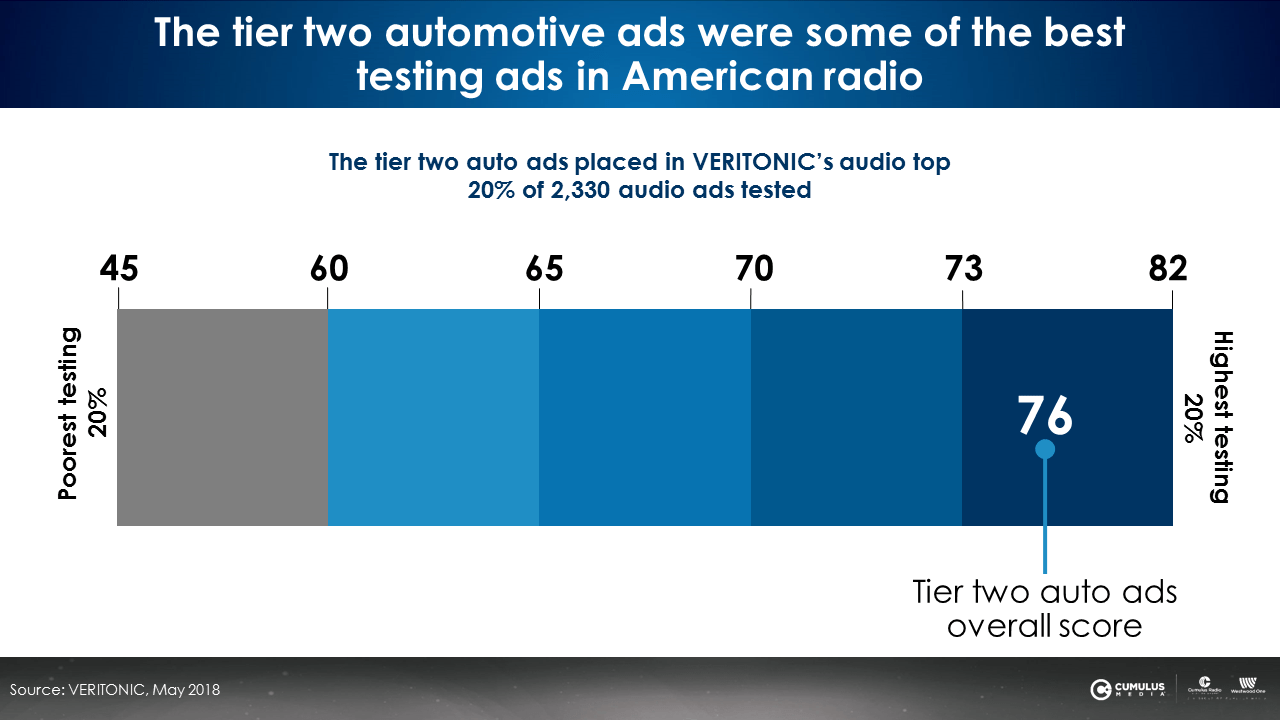
It’s OK to speed up the disclaimers: Disclaimer speed is irrelevant. Creative scores were the same for ads with sped up disclaimers and those with normal speed disclaimers. This provides tier two advertisers leeway to speed up the disclaimers to allow more time for offers and branding.
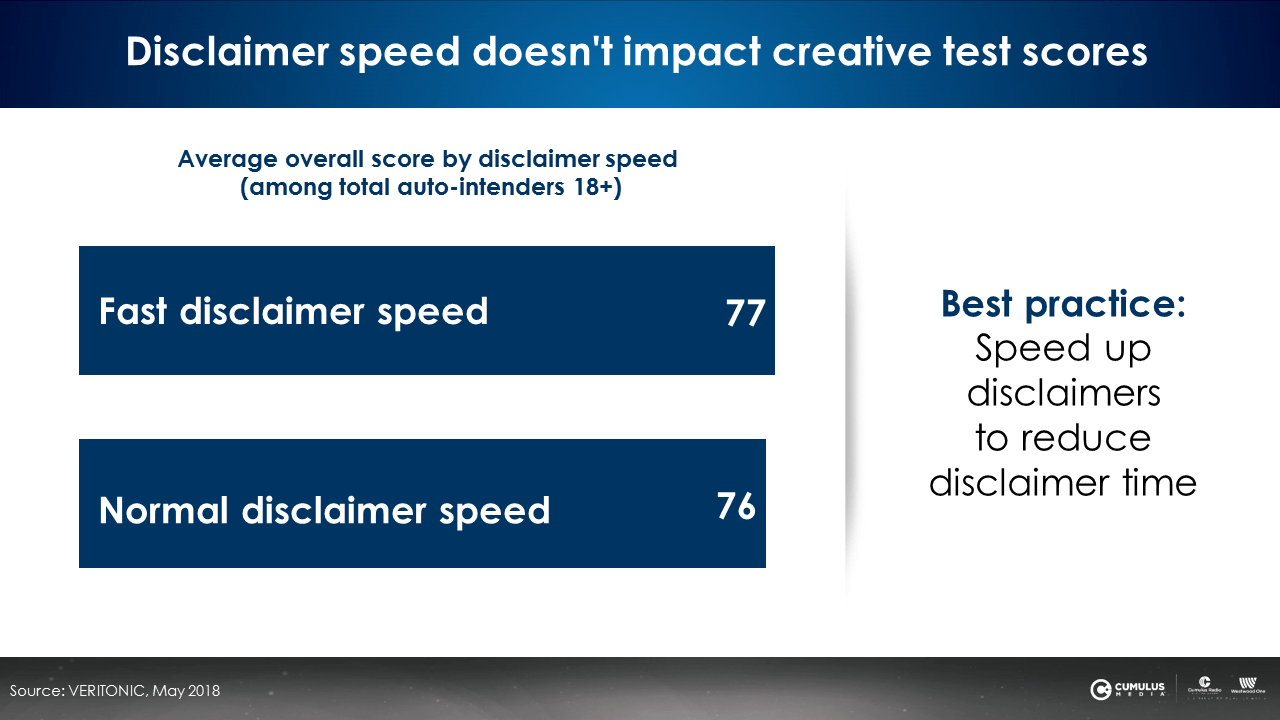
The closer the consumer is to buying a car, the better the ads performed: This is significant. Auto intenders don’t find tier two ads irritating or “uninspiring.” These ads are useful, informative, and relevant even with disclaimers.
The more imminent the auto purchase, the better the tier two radio ads tested. The tier two automotive ads tested higher among consumers in the market within the next 6 months as opposed to 6-12 months. Among imminent auto intenders, the overall creative score is +8% higher and +16% more relevant. Most significantly, the purchase intent lift is double among next six month auto-intenders versus those who intend to purchase in 6 to 12 months.
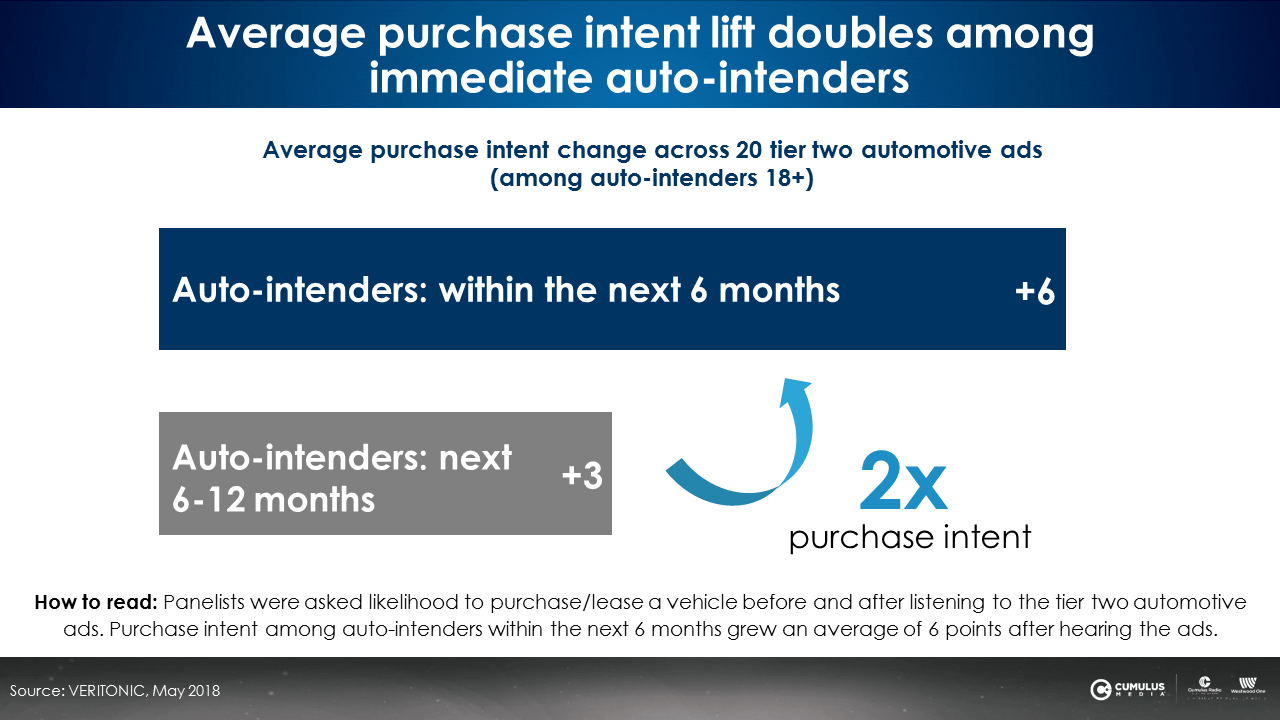
Erwin Ephron, the father of modern media planning famously concluded, “The job of advertising is to remind people of brands they know, when they happen to have a need.” Les Binet and Peter Field, the foremost experts on advertising effectiveness, find that “rational messaging tends only to strongly influence people who are close to the moment of purchase.”
Tier two auto radio ads exhibit the “strong influence” on purchase intent that represent the Binet and Field sales activation gold standard.
Good creative sells. The better the ads tested, the greater the purchase intent lift: The top 5 testing ads had a purchase intent lift 45% higher than the 5 lowest ranked ads. Strong creative drives strong purchase intent. To optimize performance, audio creative should be pre-tested.
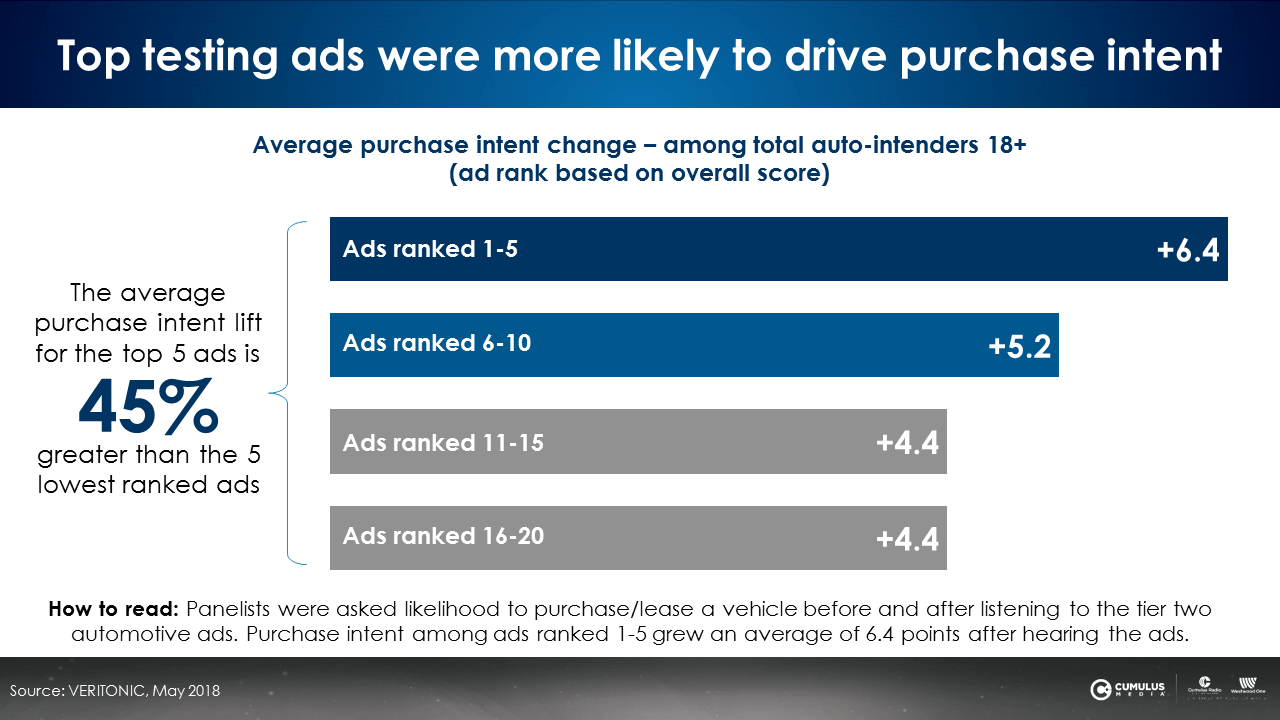
Female voiceovers tested exceptionally well and should be used more often: Investing in female voices for auto creative is a key to improve creative performance. Some of the highest performing tier two auto ads featured a female voice actor.
Since most radio ads are not tested, the creative industry has had to rely on old habits in casting radio ads. Why do most radio ads use a male voice? “It’s what we’ve always done.” This fresh data reveals radio ads should have more female voices.
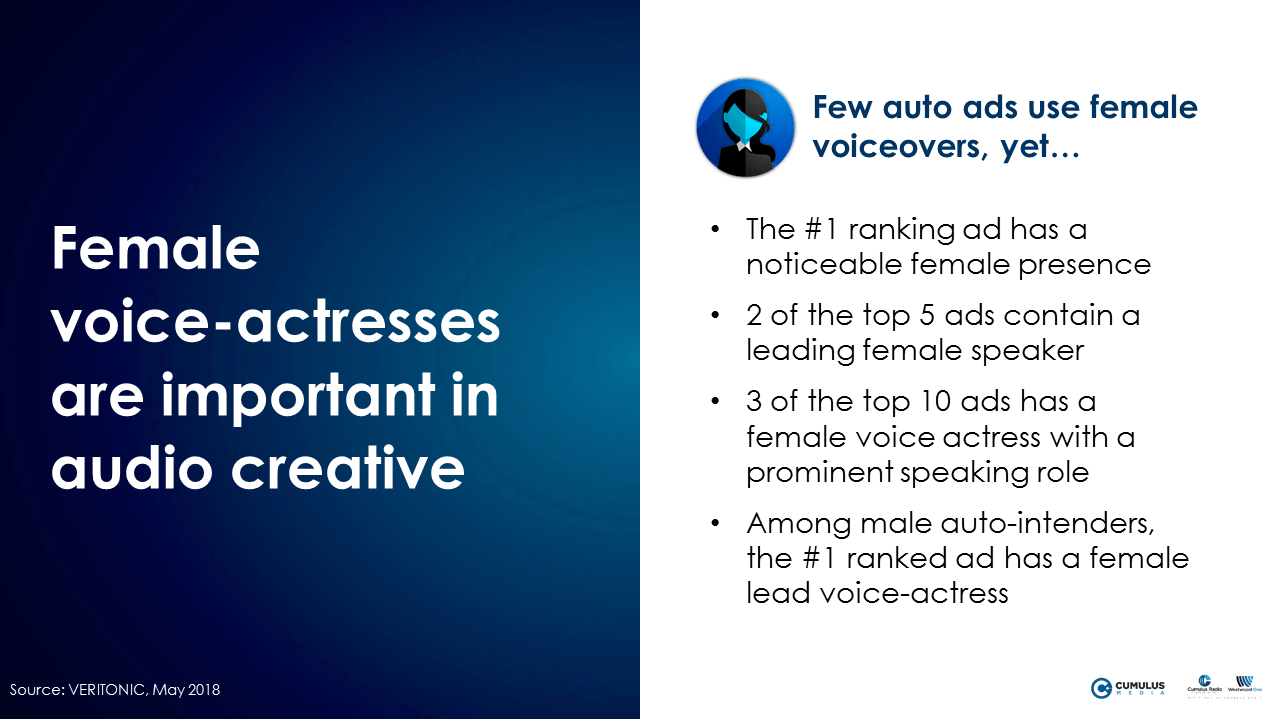
Tier two radio ads test extraordinarily well especially among auto-intenders
Do disclaimers ruin tier two radio ads? Absolutely not. This study found tier two auto radio ads were some of the best testing creative in American radio. Stacey Schulman, Chief Marketing Officer of Katz Media Group agrees, “The study debunks long-held myths about the use of disclaimers in audio advertising, offering important insights to enhance connections with in-market consumers. Thanks to this study we can clearly see the huge benefits of marrying effective audio creative with radio.”
Domestic auto brands represent the majority of tier one auto radio ads, yet only a minority of tier two auto ads. This study provides dealer associations with the confidence and hard evidence to put AM/FM radio into tier two media plans. “Understanding the positive effect of auto disclaimers for tier two automotive creative is important,” said Erica Farber, President & CEO, RAB. “This data and best practices for commercial production can only lead to enhanced conversations with radio’s automotive clients.”
This creative effective study dispelled misperceptions plaguing tier two auto AM/FM radio ads or any AM/FM radio ads with disclaimers.
Key takeaways:
- Tier two radio ads with disclaimers work for AM/FM radio: Tier two radio ads with disclaimers are some of the best testing ads on American radio. Among auto-intenders, the 60-second tier two ads with an average of 16.4 seconds of disclaimers test extraordinarily well.
- It’s OK to speed up declaimers: Disclaimer speed doesn’t impact creative scores. Speeding up disclaimers allows more time for vital branding, messaging, or additional offers.
- The more imminent the auto purchase, the better the ads tested: When consumers are in the market, offer details and specifics are relevant, informative and useful.
- Pre-test ads and invest in better creative: Strong creative drives purchase intent. The top ranked ads were more likely to drive purchase intent.
- Invest in female voices and female voiceovers: Female voiceovers test exceptionally well.
Brittany Faison is the Insights Manager at CUMULUS MEDIA | Westwood One.
Contact the Insights team at CorpMarketing@westwoodone.com.